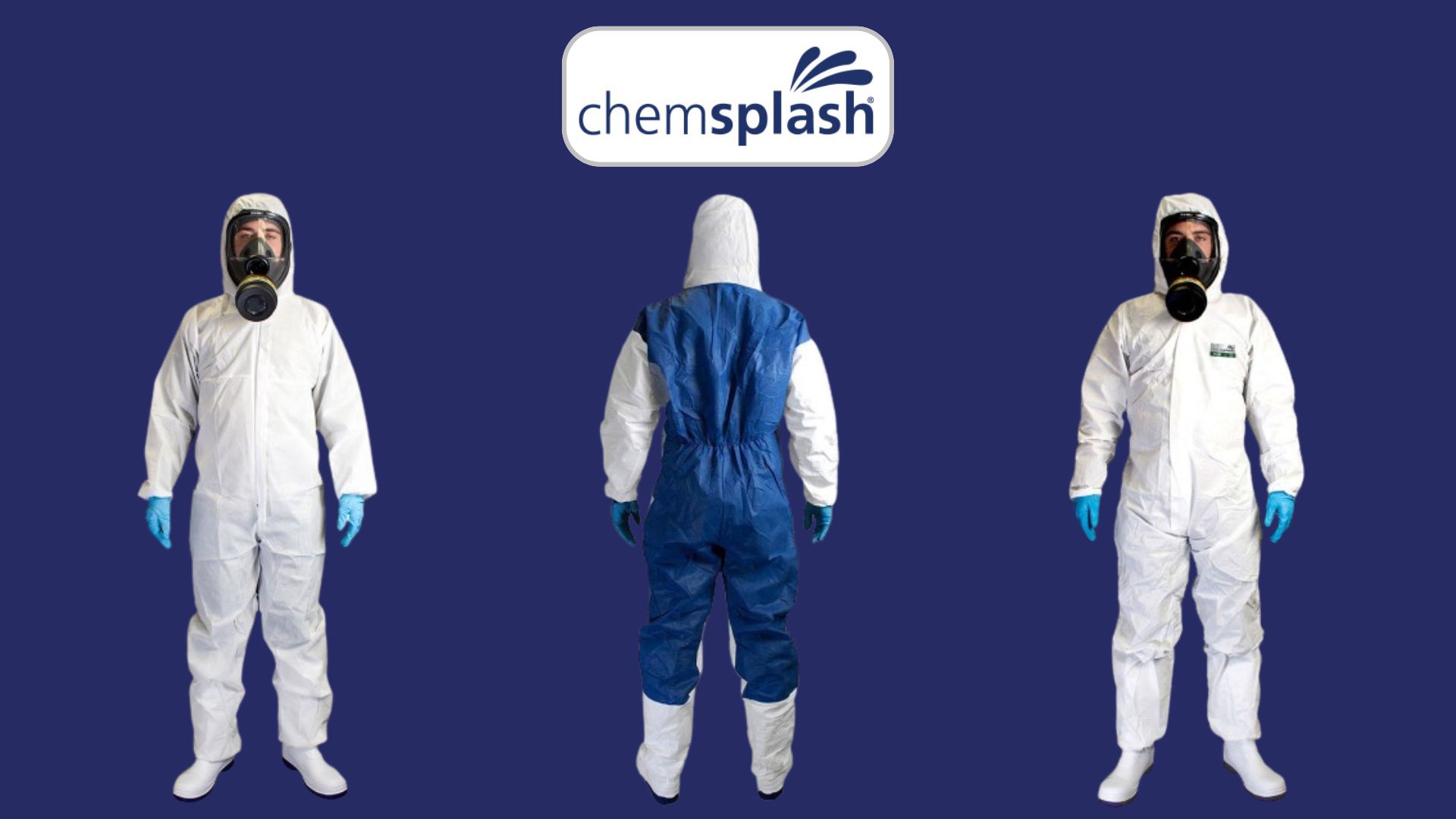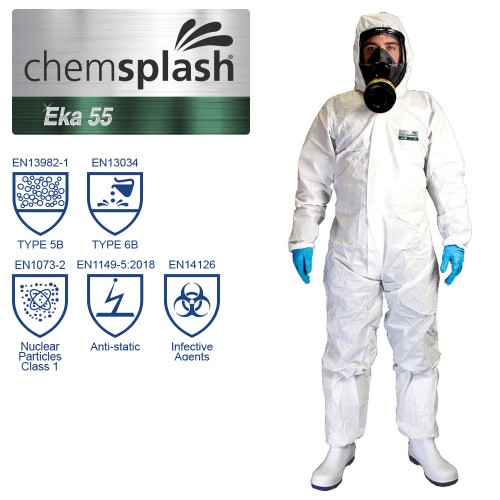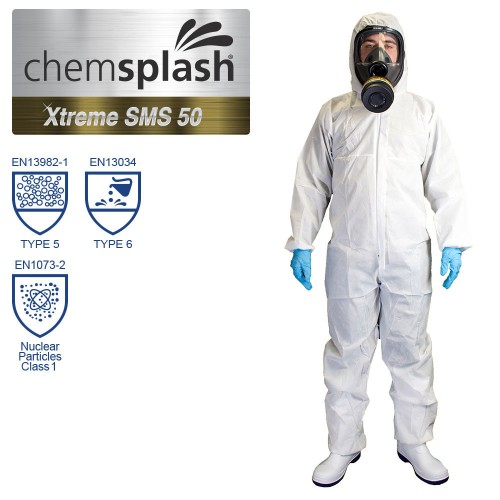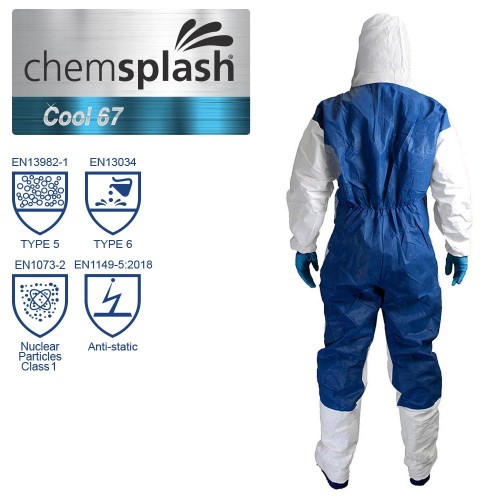Common Misconceptions About Type 5/6 Disposable Coveralls

Type 5/6 disposable coveralls are essential personal protective equipment (PPE) designed to provide protection against hazardous dry particles and limited liquid splashes. They are widely used in various industries, including pharmaceuticals, construction, and manufacturing, to ensure the safety and well-being of workers. Understanding the correct information about these coveralls is crucial to making informed decisions regarding their use.
What Are Type 5/6 Disposable Coveralls?
Type 5/6 coveralls are specifically designed to offer a barrier against hazardous particles (Type 5) and limited liquid splashes (Type 6). They are made from lightweight, breathable materials that provide comfort and flexibility while maintaining a high level of protection. These coveralls are commonly used in environments where workers are exposed to harmful dust, asbestos, and other hazardous materials, making them indispensable in maintaining workplace safety.
Debunking Common Misconceptions and Myths
Myth 1: "Type 5/6 coveralls provide complete protection against all hazards"
Many believe that Type 5/6 coveralls offer comprehensive protection against all types of hazards. However, these coveralls are specifically designed to protect against hazardous dry particles and limited liquid splashes. They are not intended for use in environments with high levels of liquid chemicals or biological hazards. Understanding the specific protection levels can help in choosing the right PPE for different hazards.
Truth: Type 5/6 coveralls provide protection against hazardous dry particles (Type 5) and limited liquid splashes (Type 6). They are not designed to shield against all types of hazards, such as chemical immersion or high biological risks. Knowing these specific protection levels ensures that workers use the right type of PPE for the hazards they face.
Myth 2: "They are uncomfortable and restrict movement"
A common misconception is that disposable coveralls are uncomfortable and limit the wearer's mobility. Advances in material technology and design have significantly improved the comfort and flexibility of these coveralls. Modern Type 5/6 coveralls are lightweight, breathable, and designed to allow a full range of motion, making them suitable for extended wear in various work environments.
Truth: Modern advancements in material science and ergonomic design have greatly enhanced the comfort and flexibility of Type 5/6 coveralls. These coveralls are now made from lightweight, breathable fabrics that allow for better airflow and reduced heat stress, enabling workers to move freely and wear them for extended periods without discomfort.
Myth 3: "Disposable coveralls are not environmentally friendly"
There is a belief that disposable coveralls contribute negatively to environmental waste. While it is true that disposables can have an environmental impact, many manufacturers are now producing eco-friendly options. These include coveralls made from recyclable materials or those designed to minimize waste. Proper disposal practices and choosing environmentally conscious products can mitigate this issue.
Truth: While disposable coveralls do contribute to waste, many manufacturers are now focusing on eco-friendly alternatives. These include using recyclable materials and creating products that reduce environmental impact. Additionally, proper disposal practices, such as following local regulations for hazardous waste, can help mitigate the environmental footprint of disposable coveralls.
Myth 4: "They are only necessary for chemical industries"
It is often thought that Type 5/6 coveralls are only required in chemical industries. In reality, these coveralls are used across a broad range of industries, including pharmaceuticals, construction, automotive, and asbestos removal. Any industry where workers are exposed to hazardous dry particles or limited liquid splashes can benefit from the protection provided by these coveralls.
Truth: Type 5/6 coveralls are used in a wide range of industries, including pharmaceuticals, construction, automotive, and asbestos removal. Any industry that involves exposure to hazardous dry particles or limited liquid splashes can benefit from the protective capabilities of these coveralls, showcasing their versatility and essential role in workplace safety.
Myth 5: "All disposable coveralls are the same"
Another misconception is that all disposable coveralls offer the same level of protection and quality. There are significant differences in the quality, standards, and certifications of disposable coveralls. It is important to select coveralls that meet the specific requirements and standards for the intended application, ensuring adequate protection and performance.
Truth: Not all disposable coveralls are created equal. There are significant variations in quality, standards, and certifications among different brands and models. It is crucial to select coveralls that meet relevant safety standards and certifications for the intended application. This ensures that the protective gear provides adequate safety and performance, tailored to specific workplace hazards.
| Chemsplash Eka 55 Schutzanzug Typ 5B/6B |
 |
Choosing the Right Type 5/6 Coverall
Key Factors to Consider
When selecting Type 5/6 disposable coveralls, several key factors should be taken into account to ensure optimal protection and comfort:
- Material: The material of the coverall is crucial for both protection and comfort. Look for materials that provide a balance between barrier protection and breathability. High-quality fabrics will offer effective protection against hazardous dry particles and limited liquid splashes while ensuring comfort during extended wear.
- Fit: A proper fit is essential for both safety and mobility. Coveralls that are too tight can restrict movement and cause discomfort, while those that are too loose may not provide adequate protection. It's important to choose a coverall that fits well and allows for a full range of motion.
- Certification: Ensure that the coveralls meet relevant safety standards and certifications, such as EN 13982-1 for Type 5 and EN 13034 for Type 6. Certifications indicate that the coveralls have been tested and meet specific performance criteria for protection.
Tips for Selecting the Appropriate Coverall for Your Needs
Selecting the right Type 5/6 coverall involves understanding your specific needs and matching them with the appropriate product features. Here are some tips to help you make an informed decision:
- Assess the Workplace Hazards: Identify the specific hazards present in your work environment. This will help you determine whether Type 5/6 coveralls are suitable or if you need additional protection.
- Consider the Task Duration: For tasks that require extended wear, choose coveralls made from breathable and lightweight materials to enhance comfort and reduce heat stress.
- Check for Compatibility with Other PPE: Ensure that the coveralls are compatible with other personal protective equipment (PPE) you may be using, such as gloves, masks, and safety goggles.
- Evaluate the Brand and Reviews: Look for reputable brands known for high-quality PPE and read reviews from other users to gauge the coverall's performance and durability.
- Test the Fit: If possible, try on the coveralls to ensure a good fit. Check for ease of movement and make sure there are no gaps that could compromise protection.
- Review Disposal Practices: Consider the environmental impact and disposal requirements of the coveralls. Opt for products that offer eco-friendly disposal options if sustainability is a concern.
By considering these factors and tips, you can choose the right Type 5/6 disposable coverall that provides the necessary protection while ensuring comfort and compliance with safety standards.#
| Chemsplash Xtreme 50 SMS Schutzanzug Typ 5/6 |
 |
Proper Usage and Maintenance of Type 5/6 Disposable Coveralls
Guidelines for Proper Usage
To maximize the effectiveness of Type 5/6 disposable coveralls, it is essential to follow proper usage guidelines:
- Correct Donning and Doffing Procedures: Ensure that the coveralls are worn and removed in a manner that minimizes the risk of contamination. Follow the recommended steps for donning (putting on) and doffing (taking off) to avoid exposure to hazardous substances.
- Layering with Other PPE: If additional PPE is required, such as gloves, masks, or face shields, ensure that the coveralls are compatible and properly layered. This helps maintain the integrity of the protective barrier.
- Inspect Before Use: Always inspect the coveralls for any defects, tears, or punctures before use. Damaged coveralls should be discarded and replaced to ensure full protection.
- Limitations of Use: Understand the limitations of the coveralls and do not use them in environments or for tasks beyond their intended protection levels. For example, avoid using Type 5/6 coveralls in situations that require higher levels of chemical resistance or biological protection.
Maintenance and Disposal
Although disposable coveralls are designed for single use, proper maintenance during use and correct disposal are crucial for safety and environmental impact:
- During Use: Avoid activities that could compromise the integrity of the coveralls, such as excessive stretching or exposure to sharp objects. Maintain awareness of the coverall’s condition throughout its use.
- Disposal: Follow local regulations and guidelines for the disposal of hazardous waste. Dispose of used coveralls in designated containers to prevent contamination. Consider eco-friendly disposal options if available, such as recycling programs for industrial PPE.
- Training: Ensure that all personnel are trained in the proper usage, maintenance, and disposal of Type 5/6 coveralls. Regular training sessions can help reinforce correct practices and update workers on any new procedures or regulations.
By adhering to these usage and maintenance guidelines, you can ensure that Type 5/6 disposable coveralls provide effective protection and contribute to a safer work environment. Proper handling also minimizes environmental impact and promotes sustainable practices in the workplace.
| Chemsplash Cool 67 Schutzanzug Typ 5/6 |
 |
Schlussfolgerung
Type 5/6 disposable coveralls are vital for protecting workers against hazardous dry particles and limited liquid splashes across various industries. Understanding and dispelling common misconceptions about these coveralls ensures that you can make informed decisions regarding their use. By choosing the right coverall, considering key factors like material, fit, and certification, and following proper usage and maintenance guidelines, you can maximize both protection and comfort.
If you have any questions or need further information about Type 5/6 disposable coveralls, Chemsplash is here to help. Our experts can provide detailed insights and recommendations tailored to your specific needs. Get in touch with Chemsplash today to ensure your workplace is equipped with the best protective gear available.
Stay safe and protected with Chemsplash.
Ihre E-Mail Adresse kann nicht veröffentlicht werden. Erforderliche Felder sind markiert*
